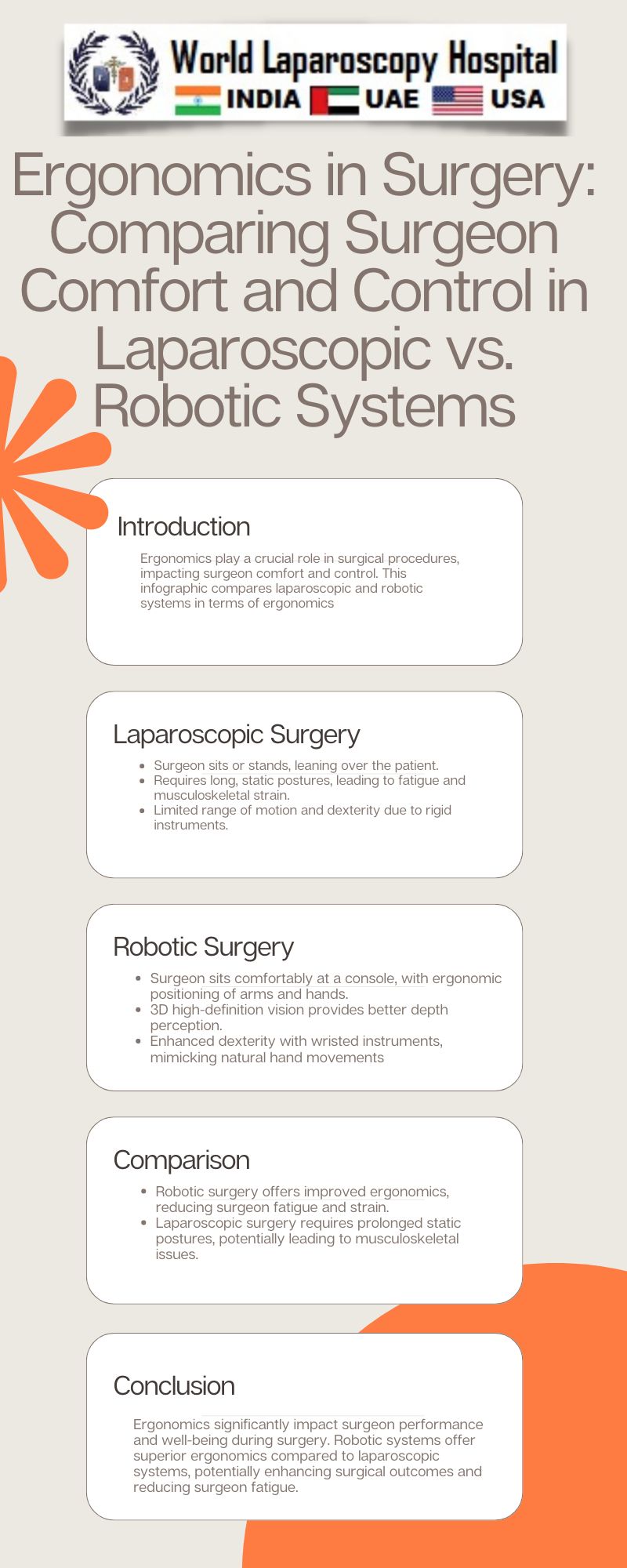Introduction
Ergonomics in surgery is a crucial consideration for both the health of the surgeon and the outcome of the procedure. Laparoscopic and robotic-assisted surgeries are two modern techniques that have revolutionized the field of surgery, offering less invasive procedures with potentially faster recovery times for patients. However, the ergonomics of these systems can significantly impact the comfort and control experienced by surgeons during procedures. This article aims to compare the ergonomic aspects of laparoscopic and robotic surgery systems, focusing on surgeon comfort and control.

Laparoscopic Surgery
Laparoscopic surgery, also known as minimally invasive surgery (MIS), involves making small incisions through which a laparoscope and other surgical instruments are inserted. The surgeon controls the instruments while viewing the surgical field on a monitor. Laparoscopic surgery offers several ergonomic benefits, including reduced physical strain on the surgeon compared to traditional open surgery. The use of long, thin instruments and a magnified 3D view allows for precise movements and better visualization of the surgical site.
However, laparoscopic surgery also presents ergonomic challenges. The fixed position of the monitor can lead to awkward posture for the surgeon, potentially causing neck and back strain. The use of long instruments can reduce tactile feedback, making it challenging to judge the amount of force applied during surgery. Additionally, the fulcrum effect, where the movement of the instrument tip is opposite to the surgeon's hand movements, can lead to fatigue and decreased precision over time.
Robotic Surgery
Robotic surgery systems, such as the da Vinci Surgical System, are advanced technologies that enhance the capabilities of surgeons during minimally invasive procedures. These systems consist of robotic arms controlled by the surgeon from a console, providing a high-definition, 3D view of the surgical site. Robotic surgery offers several ergonomic advantages over laparoscopic surgery. The surgeon sits comfortably at the console, with ergonomic hand and foot controls providing precise movements of the robotic arms. This ergonomic setup reduces physical strain and allows for more natural hand movements compared to laparoscopic surgery.
The robotic system also filters out hand tremors, further enhancing the surgeon's control and precision. Additionally, the articulating instruments of the robotic arms mimic the natural movements of the human wrist, providing greater dexterity and maneuverability in tight spaces. The improved ergonomics of robotic surgery systems can lead to reduced surgeon fatigue and potentially better surgical outcomes.
Comparative Analysis
When comparing laparoscopic and robotic surgery systems in terms of ergonomics, several factors should be considered. Laparoscopic surgery offers benefits such as reduced invasiveness, shorter recovery times, and lower costs compared to robotic surgery. However, the ergonomic challenges of laparoscopic surgery, such as awkward posture, reduced tactile feedback, and the fulcrum effect, can lead to increased surgeon fatigue and potentially lower surgical precision.
On the other hand, robotic surgery systems provide superior ergonomics, allowing for more comfortable and precise movements for the surgeon. The ergonomic setup of the robotic console reduces physical strain and offers better control over the surgical instruments. However, robotic surgery systems are more expensive than laparoscopic systems and may require additional training for surgeons to master.
Conclusion
In conclusion, ergonomics play a critical role in the success of laparoscopic and robotic surgery systems. While laparoscopic surgery offers many benefits, including reduced invasiveness and shorter recovery times, its ergonomic challenges can impact surgeon comfort and control. Robotic surgery systems, with their advanced technology and ergonomic design, provide a more comfortable and precise surgical experience for the surgeon, potentially leading to better outcomes for patients. As technology continues to advance, further improvements in surgical ergonomics can be expected, enhancing the practice of minimally invasive surgery.
From the ergonomic benefits of laparoscopic surgery to the advanced capabilities of robotic systems, every aspect is meticulously explored. The article masterfully highlights the ergonomic challenges and advantages inherent in each technique, offering a comprehensive understanding of their impact on surgical practice.
A compelling read for surgeons and healthcare professionals alike, this article stands as a beacon of knowledge in the dynamic landscape of surgical ergonomics.